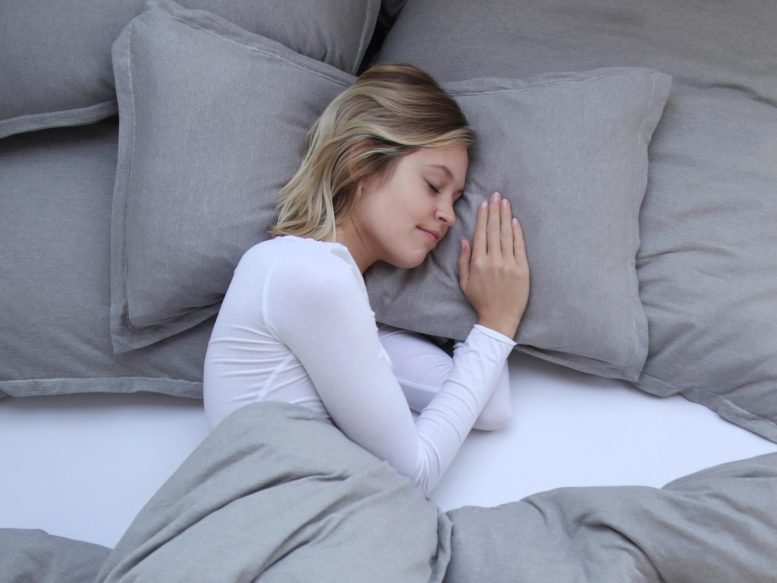
The research showed that females sleep longer than men on average throughout their lives, but they go to bed later and are more often interrupted.
A study finds when Americans get the best and worst sleep
A new study has revealed new information about the sleep habits of Americans. The Medical College of Georgia researchers found that a U-shaped pattern can be seen in a graph of how long Americans sleep over the course of their lives, with age 40 being the lowest point and hours of sleep beginning to creep back up around age 50.
Dr. Xiaoling Wang, a genetic epidemiologist at MCG’s Georgia Prevention Institute and corresponding author of the study published in the journal Scientific Reports, suggests that while researchers were surprised to find efficiency stabilized from ages 30 to 60, our sleep efficiency, which is essentially how much of the time we devote to sleeping that we actually sleep, tends to decrease throughout our lifetime.
According to the study’s first author, Dr. Shaoyong Su, a genetic epidemiologist at the Georgia Prevention Institute and a large database of participants who serve as a representative sample of the nation, measuring actual sleep duration is challenging. This is especially true given that the majority of assessments involve self-reports of sleep.
The study’s representative sampling method, wide age inclusion, and use of accelerometers to track movement and provide a more accurate estimate of participants’ sleep duration are among its main innovations.
The researchers employed a representative sample of 200 million Americans for this study: 11,279 individuals aged 6 and older from the National Health and Nutrition Examination Survey, or NHANES, which focuses on different populations or health concerns. It’s the first time that 24-hour accelerometer data from a nationally representative sample has been made accessible. Data on these individuals were gathered from 2011 to 2014 and were finally released in late 2020.
For seven days straight, participants wore accelerometers on their non-dominant wrists 24 hours a day. According to co-author Dr. Vaughn McCall, chair of the MCG Department of Psychiatry and Health Behavior and an expert in the trifecta of insomnia, depression, and suicide, even though the device does not directly measure sleep time, the idea is that measuring movement gives you some indication of whether you are asleep or not.
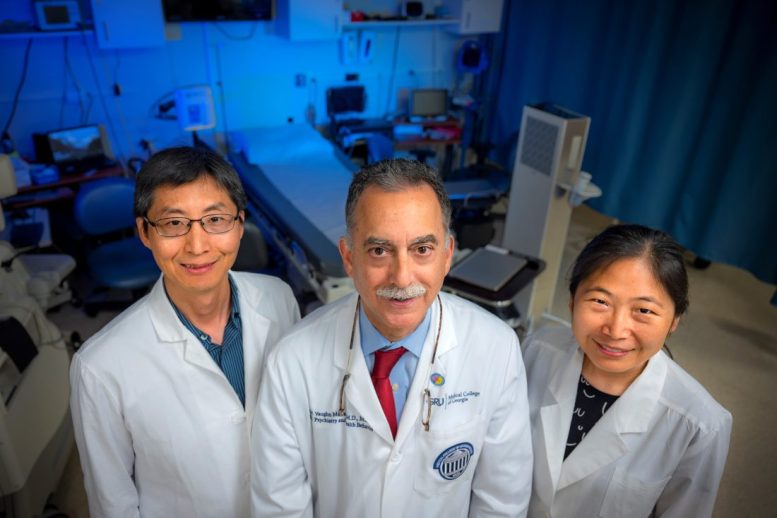
From Left Drs. Shaoyong Su, Vaughn McCall, and Xiaoling Wang. Credit: Michael Holahan, Augusta University
“We confirmed previous findings based on subjective measurement,” Su says. “People think children and adolescents sleep later and we found this. And, during middle age, people sleep less and our findings support that objectively.” Additionally, sleep duration is increased for those aged 60 and older, he says.
In this more objective assessment of sleep parameters based on movement, investigators found again that generally, nighttime sleep decreases as our age increases, although they saw the U shape emerge as sleep duration dropped significantly from about age 10 into the 50s and get a little longer after that. Studies of a large population of Japanese and French residents have shown a similar pattern. The increased sleep time later in life may reflect the reality that most Americans still retire in their 60s and simply don’t need to get up as early. Health problems and not feeling well may be another reason older American sleep longer, the investigators write, and more study is needed to look at those potential associations.
Sleep efficiency — basically the time you actually sleep versus the time you have dedicated to sleep, with 85% considered good — also tends to decrease with age, although the investigators found it stabilized from ages 30 to 60, indicating that adults maintain sleep efficiency for a long period, but may get the least sleep in their busy middle age.
“Traditionally people think sleep efficiency goes straight down with age, but we did find there is a stable period, from ages 30 to 60 years old, that you have quite stable sleep efficiency,” Wang says.
They found females generally sleep longer than males across their lives but tend to go to sleep later, particularly as they get older, and get interrupted more, particularly in taking care of children, but still net about four minutes more sleep than males.
The investigators were surprised to find that males and females were equally sleep efficient since females are more likely to report worse sleep quality and more sleep disturbances. While more study is needed to understand sex differences in sleep, sex differences should already be considered in studies and treatment of sleep health, the investigators write. Females’ sleep onset time tended to be about five minutes later than males, but before age 20 males went to bed later.
Young American adults about age 20 had the latest CTSO, or clock time for sleep onset, which is considered the time participants actually went to sleep, and high school students had the biggest weekday/weekend differences between the time they went to sleep and awakened. Those weekday/weeknight differentials only happened in school- and work-age individuals with children ages 14-17 showed the biggest differences.
For school-age children, the CTSO was 9:30 pm, which was not surprising, but that time got later through high school and hit the peak around age 21 when the average time was closer to 11:30 pm, McCall says, adding he thought it would actually be even later. The investigators note that 25% of children ages 6 to 13 had a CTSO close to 11 pm.
While there may be societal reasons, like social demands and the use of electronic media right before bedtime, these patterns also may reflect biological changes that occur during adolescence, they write. But the collective impact may be fatigue, behavioral problems, and less academic success, they write.
As they move into their 20s, a lot of people transition to work life and the CTSO begins to reverse, he says. ‘’You hit the years where you are raising children and you are working and then what happens around the time of retirement? Your whole schedule begins to change,” McCall notes, and the CTSO gets later again.
Black Americans tended to have some of the most troublesome sleep parameters, generally going to sleep later, sleeping fewer hours and less efficiently, than other races including Mexican Americans, the investigators found.
In the apparent first report of its kind, Mexican Americans had the earliest sleep onset and longest sleep time but were not necessarily efficient sleepers. The findings point to the need for more research on racial disparities in sleep that take into account social and cultural factors as well as biological and genetic factors, the investigators say.
A recent editorial in the Sleep Research Society journal Sleep Advances on cardiovascular health disparities, reports that sleep disorders and insufficient sleep are emerging as contributing factors to disparities in cardiovascular outcomes in Black patients. For example, obstructive sleep apnea, which affects about 26% of adults aged 30-70 and tends to be more severe in Blacks, has been linked to an increased risk of hypertension, coronary artery disease, stroke, heart failure, and other maladies. The investigators, including first author MCG pulmonologist Dr. William J. Healy, hypothesize that innovative approaches to addressing disparities in sleep care delivery will reduce both sleep health disparities and potentially cardiovascular health disparities.
“One thing we cannot overestimate is the impact of sleep,” notes Wang. Without sufficient sleep, “you overuse your body,” she says, and your ability to adjust to less sleep decreases with age.
While insufficient sleep itself is a risk factor for a myriad of health problems from obesity to diabetes to cardiovascular disease, it may also be an indicator of disease, says McCall who says how we sleep is like a “canary in a coal mine” and that sleep complaints may be an indication of mental or physical health problems.
“I think what these sleep parameters mean in terms of people’s health is that if you are a physician or other provider and patients comes in with some kind of complaint about their sleep, you need to interpret what they tell you in light of their stage in life and what their likely sleep patterns are going to be,” McCall says.
For example, with a 22-year-old complaining of insomnia, some of his first questions would be what time do you go to bed and how long did it take to fall asleep.
“I don’t look at our findings necessarily as a benchmark of perfect health,” McCall says. “I look at this as a benchmark of what is happening in America.”
Our more natural instincts across our lifetime likely are to go to sleep when it gets dark and wake up with the light, but life and obligations interfere with following the more natural 24-hour cycle of our internal circadian clocks, the investigators say.
Babies’ sleep patterns tend to follow these more natural circadian rhythms, Su notes. The frontier days, before television, the internet, and mobile phones, likely had more of us sleeping like babies, McCall says.
“Is it in the biology of a 20-year-old to always go to bed late or is it due to the fact that they have friends that they are engaged with and they have parties and college keg night? I think there is a lot of societal influence here,” McCall says. “Life gets in the way.”
The Georgia Prevention Institute, which has a longstanding focus on cardiovascular disease prevention, also has been using NHANES to look at how circadian misalignment, which can result from sleeping poorly, plays a role in human disease.
The National Sleep Foundation says healthy adults need seven to nine hours of sleep, those over 65 need seven to eight hours, and babies, young children, and teens need more sleep than healthy adults to enable growth and development. Newborns, who rarely sleep through the night, need 14 to 17 hours including naps.
Reference: “Epidemiology of accelerometer-based sleep parameters in US school-aged children and adults: NHANES 2011–2014” by Shaoyong Su, Xinyue Li, Yanyan Xu, William V. McCall, and Xiaoling Wang, 10 May 2022, Scientific Reports.
DOI: 10.1038/s41598-022-11848-8
Yanyan Xu, a graduate student in genomic medicine at AU studying with Wang is a co-author of the study. Co-author Dr. Xinyue Li, a biostatistician in the School of Data Science at the City University of Hong Kong, used an algorithm she developed to better assess actual sleep time using the information provided by the accelerometer.
The study was funded by the National Institutes of Health and the American Heart Association.

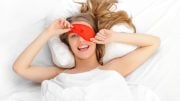
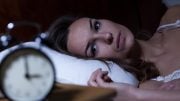
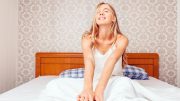
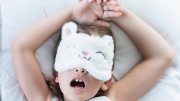

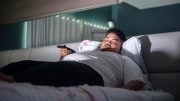


Gender huh? I thought gender was a societal construct…..
Sex which is based on genetics would make sense.
It is sad to see a scientific media company that can’t even get the science straight.
If the internet is causing us to get less sleep, maybe reparations are in order; maybe Google should pay a tax to fund sleep research?